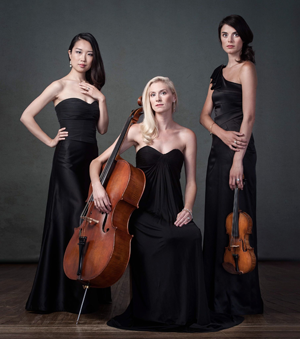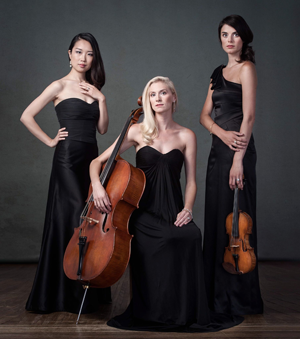
Photo by Bonnie Rae Mills
Aleron Trio, a much traveled and superstition-free ensemble, a product of the S.F. Conservatory of Music, is opening the season Friday, The Thirteenth, in Old First Church with a spectacular program.
Violinist Solenn Séguillon and cellist Anne Suda started Aleron three years ago, while still Conservatory students, joined last year by pianist Sophie Xuefei Zhang, who is getting her certificate in chamber music from the Conservatory.
The novelty on the concert is the Aleron-commissioned world premiere of contemporary Persian composer Shahab Paranj’s first piano trio, A Bitter Letter. “We have thoroughly enjoyed immersing ourselves in the sounds and culture of classical Persian music,” says violinist Séguillon, “and are thrilled to bring this exciting new work to our San Francisco audience.”
Also on the program will be Beethoven’s Ghost Trio as well as Dvorák’s Dumky Trio, which explores themes from traditional Czech music.
Paranj, born in Tehran in 1983, is based in the San Francisco Bay Area. Known for championing Persian music and culture throughout the world, Paranj’s style blends Persian rhythmic and melodic influences with Western texture and form.
Shahab Paranj’s Piano Trio No. 1 is composed in three movements, influenced by traditional classical Persian music.
Only a very small portion of music from ancient Persia is known. The primary reason that the body of surviving works is so small is the repeated invasions of Iran throughout history. Music, being one of the most fragile elements of any culture, is often the first to be lost.
Of these invasions, that of the Islamic Arabs was the most damaging to Persian culture and music. The raison d’etre of Persian music after this invasion became almost exclusively that of religious mourning or Taazie. Thus surviving lyrics and melodies from this era are mostly sad and sorrowful.
The traditional, classical Persian melodic system, raa-dif, consists of seven dast-gah, which organize melody into a number of different “tonal spaces.” The specific characteristics of raa-dif are twofold: The pitch structure is microtonal and the rhythm tends to be “limping” in uneven or additive meter. These two elements give a predominantly monophonic texture great variation.
Paranj’s Piano Trio No. 1 is based on two dast-gah: chahar-gah and homayoun. Each follows a specific melodic, rhythmic, and harmonic syntax. Movement I is based on chahar-gah, which emphasizes a vocal, parlando style with very free, almost a-metrical, rhythmic phrasing.
Movement II is based on an ostinato, presented in the piano, above which is juxtaposed Azeri folkloric and Persian chahar-gah melodies in the violin and cello. Instead of the mournful Taazie feeling of the previous two movements, in Movement III motives from the first two movements are combined with new material in the homayoun dast-gah, to create a vibrant rhythmic and jubilant, and ultimately triumphant finale.

